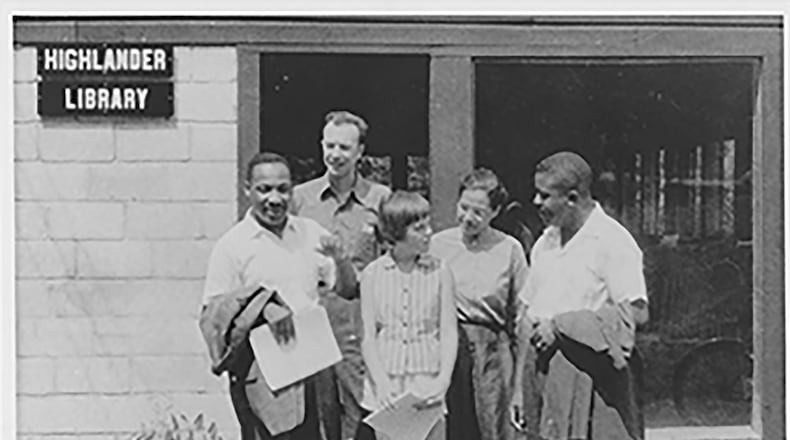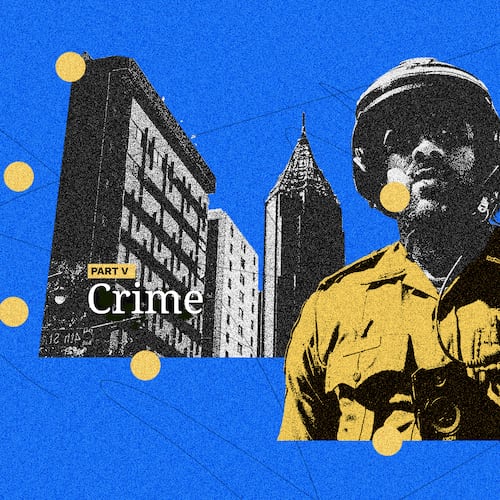By many accounts, the Highlander Research and Education Center has been so effective through most of its 87-year history because of its remote location.
That the social justice incubator is miles away from heavily populated areas made it something of an oasis for civil rights leaders from Atlanta and all over the country. There, in the Tennessee mountains, they strategized, organized and found a little peace while standing on a porch, enjoying the stillness.
But the bucolic isolation that nurtured movements, from the Montgomery Bus Boycott to more recent community organizing in southwest Georgia, may well have helped make the Highlander Center a target.
Last week, Tennessee arson investigators and sheriff's detectives combed through the charred remains of the Highlander's main administrative building, which was destroyed in an early morning fire on March 29. Authorities announced they were focusing on a symbol that had been spray painted on pavement near the rubble.
The design — resembling a hashtag or tic-tac-toe grid with an additional horizontal and vertical line — is used by white supremacists and has origins in the fascist Romanian Iron Guard of the late 1920 through the 1930s, according to Allison Padilla-Goodman, Southeast regional director of the Anti-Defamation League. The grid is meant to represent the intersection of a cross and prison bars, Padilla-Goodman said. It was painted on one of the guns used by the man who live-streamed his massacre of 50 Muslims in two New Zealand mosques last month. It was also painted, along with swastikas, on the University of Tennessee-Knoxville campus in November.
The Jefferson County Sheriff’s Department and the Tennessee State Fire Marshall’s office declined to comment on the Highlander investigation on Friday. Yet, in Georgia, veteran civil rights leaders who received nonviolence training at Highlander, said the center has always been a target.
“We felt the location didn’t offer any distractions, and the atmosphere lended itself to the purpose for being there,” said Bernard Lafayette, one of the early organizers of the Student Nonviolent Coordinating Committee and a member of Martin Luther King Jr.’s inner circle. “We had a holistic environment.”
Yet, if the fire turns out to be arson, “I am not surprised, because it got a lot of threats when I was there,” said Lafayette, who lives in Alabama. “And remember, (segregationists) had a photograph of Martin at Highlander on billboards on highways back then calling it a Communist school. So, I’m surprised it survived that long.”
“Listen to the People”
Before firefighters could put out the blaze, Charis Horton, 74, started getting texts from friends telling her that the school her father helped found was in trouble. Luckily, a trove of records, photographs, films, documents and recordings from the early days — when the center was known as the Highlander Folk School — had been given to the Wisconsin Historical Society State Archives years earlier, she said. The material represents a deep well of information, from as early as the 1930s, about the foundation of the nonviolent resistance movement in the United States.
Still, in a statement on the Center’s Facebook page last week, representatives of the organization said, “The fire destroyed decades of historic documents, speeches, artifacts and historic memorabilia from movements of all kinds, including the civil rights movement.” Representatives from Highlander did not respond to requests for comment late this week.
Horton’s father, Myles, was a seminary student at Union Theological Seminary and later a graduate student at the University of Chicago when he became interested in Danish folk schools and their philosophy. The schools emphasized the importance of bringing people together and letting them come up with their own solutions to pressing problems.
After traveling to Denmark to study them, Horton, a Tennessee native, got a donation of land to start the first iteration of the Highlander school in Monteagle, Tenn., in 1932. Horton, who was white, initially focused on interracial labor union organizing. In time, the school's focus turned to social justice and civil rights as activists and organizers such as Septima Clark, a cornerstone of the civil rights movement," were hired on staff.
Clark developed literacy programs for disenfranchised African Americans, but also served as director of workshops. In that role, she is credited with training Rosa Parks, who would later spark the Montgomery Bus Boycott with her refusal to give up her seat on a bus to a white man.
“His belief was that you didn’t give people solutions; you set up a place where they can talk,” Charis Horton said of her father. “It doesn’t help people to tell them what to do. It was: Listen to the people in the trenches, because they will find strong solutions.”
“Of the Same Spirit”
Lafayette said one of his most vivid memories of being at Highlander was when Myles Horton asked him during a session why he wanted integration. As Lafayette remembers, Horton followed the query up with, ‘“Aren’t you happy with your people?”
“It was my first encounter with the concept of devil’s advocate,” Lafayette said. “Since I didn’t know him that well, I didn’t know if he was serious or not. But it was a teachable moment for me because it made me think that we didn’t want to be with white folks just to be with white folks, but we were dealing with the issue of equal opportunities.”
What made the school unique in the South was that it was one of the few places where black people and white people could work together and challenge each other without fear of reprisal.
Former U.N. Ambassador Andrew Young almost took a job at Highlander before the Monteagle campus was shut down by Tennessee law enforcement officials in 1961 on grounds it violated its nonprofit charter. Young called the school “one of the few, if not the single most important, institutes offering training and advocating nonviolence.”
Juanita Abernathy, the widow of key civil rights leader Ralph Abernathy, remembers not only her husband training at Highlander. She spoke there, attended workshops, and felt as though Horton and the other white people there “didn’t have a white supremacist bone in their bodies.”
The school was under FBI surveillance. Its phones were tapped, said Charis Horton, who grew up on the Monteagle campus. Between 1961 and 1971, when the school operated out of an old home in Knoxville, the Ku Klux Klan marched in front of it. That house was also where the Hortons lived. On another occasion, a Molotov cocktail was thrown through a front window of the house, she said, though it didn’t do serious damage.
“They didn’t like Myles Horton or people of the same spirit,” Abernathy said. “When you came through the Highlander Folk School, you couldn’t be controlled because you’ve been taught the spirit of nonviolence and you had a spirit of inclusiveness.”
“On the Battlefield”
By the 1970s, the school was renamed the Highlander Research and Education Center and moved to its current, 200-acre location in New Market. It expanded its focus to environmental issues, such as strip mining and toxic waste. Yet, it didn’t turn completely turn away from civil rights.
Shirley Sherrod, director of the Southwest Georgia Project in Albany, which focuses on rural and agricultural issues, attended training at Highlander in the 1990s. Her husband, Charles Sherrod, had trained there in the 1960s while a field director for the Student Nonviolent Coordinating Committee. In recent years, her organization has sent youth leaders to weekend workshops at Highlander. It provided an opportunity for those students to share and take away the best examples of how to deal with issues confronting the rural South, from voter registration to community organizing, Shirley Sherrod said.
“I can’t remember ever being afraid there,” she said.
While the fire investigation has not concluded that white supremacists were responsible for the cross symbol found at Highlander, white supremacist activity has been on the rise in that part of Tennessee, said the Anti-Defamation League’s Padilla-Jones. According to the ADL’s interactive map that tracks possible extremist and anti-Semitic activities nationally, between 2013 and 2016, only one recorded white supremacist event or incident was recorded in the Knoxville area. Between 2017 to now, the ADL has identified 12 such incidents. The organization attributes the rise, partially, to a small group of white nationalists operating in the area.
But Charis Horton and others say the work that takes place at Highlander has survived intolerance in the past and will survive this time, too. A cluster of buildings remain, and the destroyed one likely will be rebuilt.
“My father said, ‘You can padlock a building, but you cannot padlock an idea,’” she said.
Why it matters
The Highlander Research and Education Center in Tennessee was a retreat and training ground in nonviolent protest for civil rights leaders. Rosa Parks, Martin Luther King Jr., Ralph Abernathy and Septima Clark trained there when it was known as the Highlander Folk School. Historically, it has received threats from those opposed to its mission.
About the Author
The Latest
Featured


